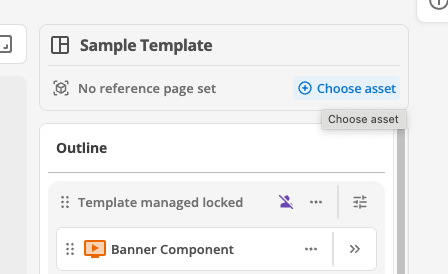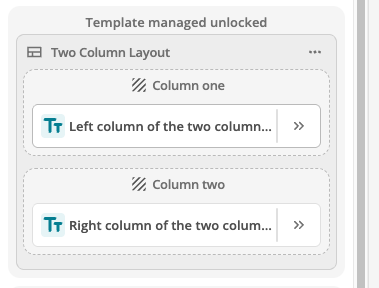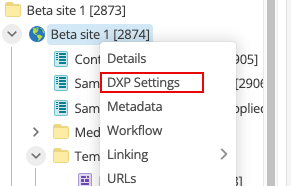How to create a content template
Creating a template is done entirely within the page builder user interface. It is a no-code process.
Content templates are a specific asset type in the Squiz Content Management System. They are used to create reusable content page patterns.
Create the new Content Template asset by using the Designs and Templates tutorial in the Squiz Content Management documentation as a guide.

Using the template builder user interface
The interface is a modified version of Page Builder, often indicated by purple UI elements to distinguish it from the regular content page editing experience.
Defining content zones
A template is organized into Content Zones.
To structure a template, the template author can do the following:
-
Add zones.
-
Rename zones.
-
Configure multiple zones.
Adding content to zones
After you define content zones, add text blocks, components, and layouts.
Set placeholder content and images as guides for page editors.
| Content added here is considered template-managed by default. |
Configuring zone behavior
Content templates support three distinct zone management types that determine who controls the content and components within each zone.
For detailed information about zone management types and configuration options, see Zone management: Content control.
The primary content zone
One zone can be designated as the primary content zone.
When a template is applied to a page that already has content, that content will be moved into this specific zone.
For detailed information about primary content zones, see Primary content zone.
Setting zone rules
Zone rules restrict the content types page editors can add to page-managed zones.
For detailed information about configuring zone rules, see Advanced configuration: Rules and IDs.
Using zone IDs for template evolution
Each zone has a unique Zone ID.
These IDs are critical because they enable content to flow correctly to the intended location, even if a template’s structure is later modified.
Selecting a reference asset
-
Access Squiz CMS.
-
Click the Create New option.
-
Navigate to .
-
Enter a descriptive Name for the template (for example, News Article Template).
-
Choose a Link Type. Select either Menu or Hidden.
-
Click Create.
-
A modal window appears, providing asset details and an Edit link.
Building the template structure and defining context
Once the asset is created, define the context and start structuring the content zones within the editor.
Changes are made on the Content tab in Build mode.
Setting the reference asset
Set the Reference Asset (Preview Context) by selecting a reference content page.
This is considered pivotal for ensuring Preview mode functions correctly, as it provides the site design and menu context but strips out its own content for the template build.
Understanding reference assets
A reference asset, specifically a reference page, is a content page chosen by the user in the Template Builder.
Its purpose is to provide the necessary context for the template’s preview.
Reference assets are used because templates themselves cannot be directly browsed or published, as they lack a URL and are not exposed on the frontend.
The reference asset provides the template with information, such as the site’s design, menus, and overall visual context. This allows the Template Builder to display an accurate preview of how the template will look when applied to a live page.
When selected for use as a reference asset, the content of selected page is not included; only the page’s design elements are used for reference.
|
The selected page’s contents are not removed from the page. Selecting a page for use as a reference asset simply allows the page’s structural elements to be referenced by the template. |
Selecting a reference asset
From the content template asset, use the choose asset link to select a reference page:

A reference asset has been selected when the preview area in the template builder displays the template elements within the page context.
|
Reference asset requirements
A template can still be built without a reference page; however, no inline editing functionality will be available. The reference asset is essential for proper preview functionality. |
Applying templates to content pages
Templates can be applied to both new and existing content pages, with different behaviors depending on the page state.
Applying templates to new pages
Create a new content page and apply a template during the page creation process:
-
Create a new content page from the asset tree in the Squiz CMS.
-
From the content screen on the new page, select the + button to apply a new template.

-
Once the template has been applied, you will see the zones and content items defined in the template on the page.
Applying templates to existing pages
When applying a template to a page that already contains content, the system handles content reflow automatically:
- Content migration
-
If a primary content zone was designated in the template, all existing page content is moved into that zone.
- No primary zone
-
If no primary content zone was designated, existing content remains on the page but may be moved to an "unused content" area.
- Unused content management
-
Content that cannot be placed in template zones appears in an unused content panel, where users can:
-
Move individual content back into an allowed zone on the page
-
Confirm deletion of all unused content
-
Template enforcement
Once a template is applied, zone rules and restrictions are enforced:
- Template-managed zones
-
No new components can be added to template-managed zones.
- Content restrictions
-
Restrictions are adhered to in page-managed zones based on the zone’s rules.
- Component movement
-
Moving components within the template respects zone restrictions.
- Visual indicators
-
Content editors see inline indicators and outline warnings that explain zone restrictions.


Publishing and managing templates
Publishing templates
After completing template configuration, publish the template to make it available:
-
Select the Approve and Make Live option to publish the template.

-
Templates are Squiz Content Management assets that adhere to standard CMS publishing workflows.
Making templates available on sites
One additional step is needed to make the template available on a site:
-
Within the DXP Settings page, navigate to the Content template section.

-
Templates must be added to this list before they are available for content editors to add to pages. If there are no templates set up on the site, the Apply template area mentioned in Applying templates to content pages does not appear.

This additional setting gives site builders and administrators more control over the templates that can be actively used on a site.
Personalization in templates
Templates support personalization features that allow content to be customized based on user segments or A/B testing scenarios.
Applying personalization to components
Personalization can be applied to components within templates:
-
Select a component within the template builder.
-
Use the personalization settings for that component.
-
Configure personalization rules based on user segments or A/B testing criteria.
-
Set different content variations for different user groups.
Personalization considerations
When using personalization in templates:
- Content variations
-
Ensure all personalization variations are properly configured before publishing the template.
- Testing
-
Test personalization rules thoroughly to ensure they work as expected.
- Performance
-
Consider the performance impact of personalization on template rendering.
- Documentation
-
Document personalization rules for content editors who will use the template.
Template updates and version management
Templates support version management and updates that cascade changes to all pages using the template.
Updating templates
When template changes are made and published:
- Automatic updates
-
Changes automatically cascade out to all pages using the template.
- No bulk update process
-
Templates are not deployed but applied. Therefore, and unlike components, there is no utility in a template bulk update process.
- Immediate effect
-
Because templates are deployed, template updates take effect immediately on all pages that use the template.
Template update considerations
When updating templates:
- Content compatibility
-
Ensure template updates do not break existing content.
- Zone ID preservation
-
Maintain zone IDs to ensure content flows correctly.
- Testing
-
Test template updates on a copy before applying to production.
- Communication
-
Notify content editors of template changes that might affect their work.
Best practices for template updates
- Plan changes carefully
-
Consider the impact of changes on all pages using the template.
- Document changes
-
Document what changes were made and why.
- Test thoroughly
-
Test template updates in a development environment first.
- Monitor impact
-
Monitor the impact of template updates on live pages.
|
Template update impact
Template updates take affect immediately on all pages that use the template. There is no way to apply template updates to specific pages selectively. |